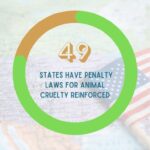Animal cruelty is a grave concern that resonates deeply within societies worldwide. With an ever-increasing awareness of our furry, feathered, and scaled companions, one might ponder: how many cases of animal cruelty are reported each year? This inquiry not only beckons for an answer but also demands a more profound contemplation of the systemic issues that incite such egregious behavior.
To comprehend the magnitude of animal cruelty each year, we must first acknowledge the myriad forms it can take. From neglect and abandonment to organized cruelty and exploitation in industries such as factory farming, animal testing, and even entertainment, the statistics are alarming. The figures surrounding reported cases are staggering, revealing a dark facet of humanity that continues to persist, challenge, and provoke.
According to estimates, millions of incidents of animal cruelty occur annually across the globe. In America, a prominent portion of this data is gathered by organizations monitoring animal welfare. However, these figures often represent only the tip of the iceberg. Many acts of cruelty remain unreported due to societal stigma, lack of awareness, or insufficient resources to investigate such instances. This void propels the illusion that animal cruelty is less prevalent than it truly is.
Statistics reveal that approximately 1 million reported cases of animal cruelty occur in the United States each year. This number, while impressive, only accounts for reported incidents. In the United Kingdom, the figures fluctuate annually, yet public awareness campaigns have significantly raised consciousness around this plight, prompting more individuals to report suspicious behaviors. Each case represents not merely a statistic but a life suffering needlessly.
Delving deeper into the statistics unveils not only the volume of cruelty but also the nature of the perpetrators. Studies have indicated that the demographics of those who commit acts of violence against animals vary, but a notable correlation exists surrounding socioeconomic factors. Individuals from impoverished backgrounds or those suffering from emotional or psychological impairments have been statistically more inclined to engage in such behavior. This knowledge poses a compelling challenge: how do we address the root causes of this cruelty while concurrently advocating for the protection and welfare of animals?
The role of education cannot be overstated. The implementation of educational programs aimed at teaching compassion towards animals from a young age is integral. Children who grow up with a profound understanding of empathy towards animals are less likely to engage in cruel behavior as they mature. Since many reports of animal cruelty arise from ignorance or a lack of understanding about proper pet care, awareness initiatives serve as a preventative measure.
Furthermore, animal welfare organizations and local shelters are crucial in advocating for stronger laws and regulations against animal cruelty. Yet, despite their relentless efforts, many jurisdictions fall short of adequate legislative measures to protect animals. A lack of stringent legislation leads to inadequate punishment for perpetrators, perpetuating a cycle of abuse and neglect. As global citizens, we have a responsibility to challenge our lawmakers to enforce stricter penalties against those who engage in cruelty.
Analyzing the international perspective, countries such as China and Japan report distressing levels of animal cruelty as well. Cultural attitudes toward animals vary significantly across regions, affecting the prevalence and acceptance of cruelty. For instance, while some nations enact progressive laws to protect animals, others lag behind, often viewed through cultural lenses that prioritize economic benefits over ethical treatment.
Moreover, the advent of the internet has inadvertently fueled a darker aspect of animal cruelty. Online platforms often become breeding grounds for organized abuse, where illegal activities such as dogfighting or exotic animal trade proliferate. Statistically, reports of such cases have surged alongside the rise of social media. Tracking these incidents, however, poses significant challenges for law enforcement, as they navigate the intricate web of online anonymity.
Another disturbing statistic emerges from the research surrounding animal testing. The number of animals subjected to various forms of experimentation, often in distressing conditions, extends into the millions globally each year. Despite growing public outcry against such practices, the justification for animal testing in scientific research remains a contentious issue. The ethical dilemma thus posed shines a spotlight on the intersection of science, consumer demand, and animal rights. What sacrifices are we willing to make in the name of progress?
The cumulative consequences of neglect, abandonment, and cruelty have far-reaching implications not just for the animals involved, but for society as a whole. Victims of cruelty may experience severe physical and psychological trauma, and studies have shown a troubling link between animal abuse and human violence. This correlation obligates us to confront some uncomfortable truths: To neglect animal rights is to disregard a fundamental aspect of humanity itself.
As the statistics loom large and continue to rise, individuals and communities are encouraged to take up the mantle of advocacy. Reporting suspected cruelty, supporting local shelters, and fostering a culture of compassion can instigate meaningful change. In our quest to protect those who cannot speak for themselves, it is vital to ask: what can each of us do to ensure a more humane world for all living beings? The answer lies not just in awareness, but in actionable change.
The time has come for society to rise as one against animal cruelty. Awareness, education, and advocacy hold the power to illuminate the darker corners of this issue and prompt vital conversations. The shocking statistics serve as a clarion call—an urgent reminder that our collective efforts can indeed catalyze profound change. Together, we can work towards a world where every creature roams free from fear and abuse.








